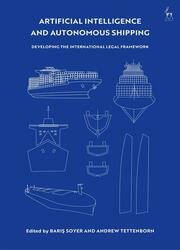 Название: Artificial Intelligence and Autonomous Shipping: Developing the International Legal Framework
Название: Artificial Intelligence and Autonomous Shipping: Developing the International Legal FrameworkАвтор: Barıs Soyer, Andrew Tettenborn
Издательство: Hart Publishing
Год: 2021
Страниц: 231
Язык: английский
Формат: pdf (true)
Размер: 18.9 MB
In simple terms, Artificial Intelligence (AI) is the process of simulating human intelligence through machine processes. It dates back at least to the 1950s. In the maritime field, following the successful harnessing of computer technology over more than five decades to operate underwater vehicles remotely for military and scientific purposes, attention turned at the turn of the millennium to the problem of designing vessels with the ability through Artificial Intelligence to make their own navigational decisions and determine their actions autonomously.
The most influential research programme aimed at developing ‘a technical concept for the operation of autonomous merchant vessels’ and assessing its ‘technical, economic and legal feasibility’ arguably was the Maritime Unmanned Navigation through Intelligence Networks (MUNIN) project, co-funded by the European Union. This was a concept study, which ended in August 2015, aimed at identifying the most critical technological, operational and legislative factors that might obstruct the development of autonomous shipping.
Similar studies, mainly driven by engineering and IT firms, have been launched since then with the encouragement and financial support of some Nordic countries. Some of these studies have utilised lessons learned from remote operation in industries such as aviation, space exploration and defence, resulting in the use of interactive smart screens, voice recognition systems, holograms and surveillance drones to monitor and assess onboard operations and conditions around the vessel. The ultimate aim of all these projects was to produce a viable model which could be subjected to actual sea trials. This object was partially achieved in December 2018, when Finnish state-owned ferry operator Finferries, in collaboration with Rolls-Royce, tested the navigation of the world’s first fully autonomous ferry, the Falco, in the archipelago south of the city of Turku. During the test, the Falco, a 54-metre double-ended car ferry, successfully navigated autonomously for about a mile and half. Similarly, Yara and Kongsberg have entered into partnership to build the world’s first autonomous zero emission ship, the YARA Birkeland.
In addition to the technological challenge of developing the autonomous operation machinery as regards ships, there are equally important shoreside challenges. We need fairly quickly to establish codes and practices to standardise the security, quality and integrity of the data generated by autonomous ship operations. In addition to this there are training requirements; we need a new and different generation of naval architects, technicians and engineers, not to mention new roles in cybersecurity and operational management. But that is only one side of the equation. To make autonomous shipping a reality, the infrastructure in ports needs to be developed in a parallel fashion. For example, shore facilities, such as automated mooring systems and shore power hook-up, will be necessary for autonomous vessels. This may also include high-accuracy positioning systems, better communication infrastructure and other facilities to simplify the critical port approach and departure phases.
The challenge is however not merely technical, but legal and regulatory. True, states naturally have jurisdiction to regulate internal trade and events within their internal waters; but the majority of maritime law principles are of an international character, developed through customary international law and international treaties. Many of these rules operate on the assumption that a human being will be in charge of a vessel. This may or may not matter as regards individual instances: but it means that to make the operation of autonomous vessels a reality outside internal waters, it is necessary to explore to what extent each existing rule of public and private maritime law (and the law of the sea) may require amendment. International regulators are now aware of this and have begun to take up the challenge.
Скачать Artificial Intelligence and Autonomous Shipping: Developing the International Legal Framework